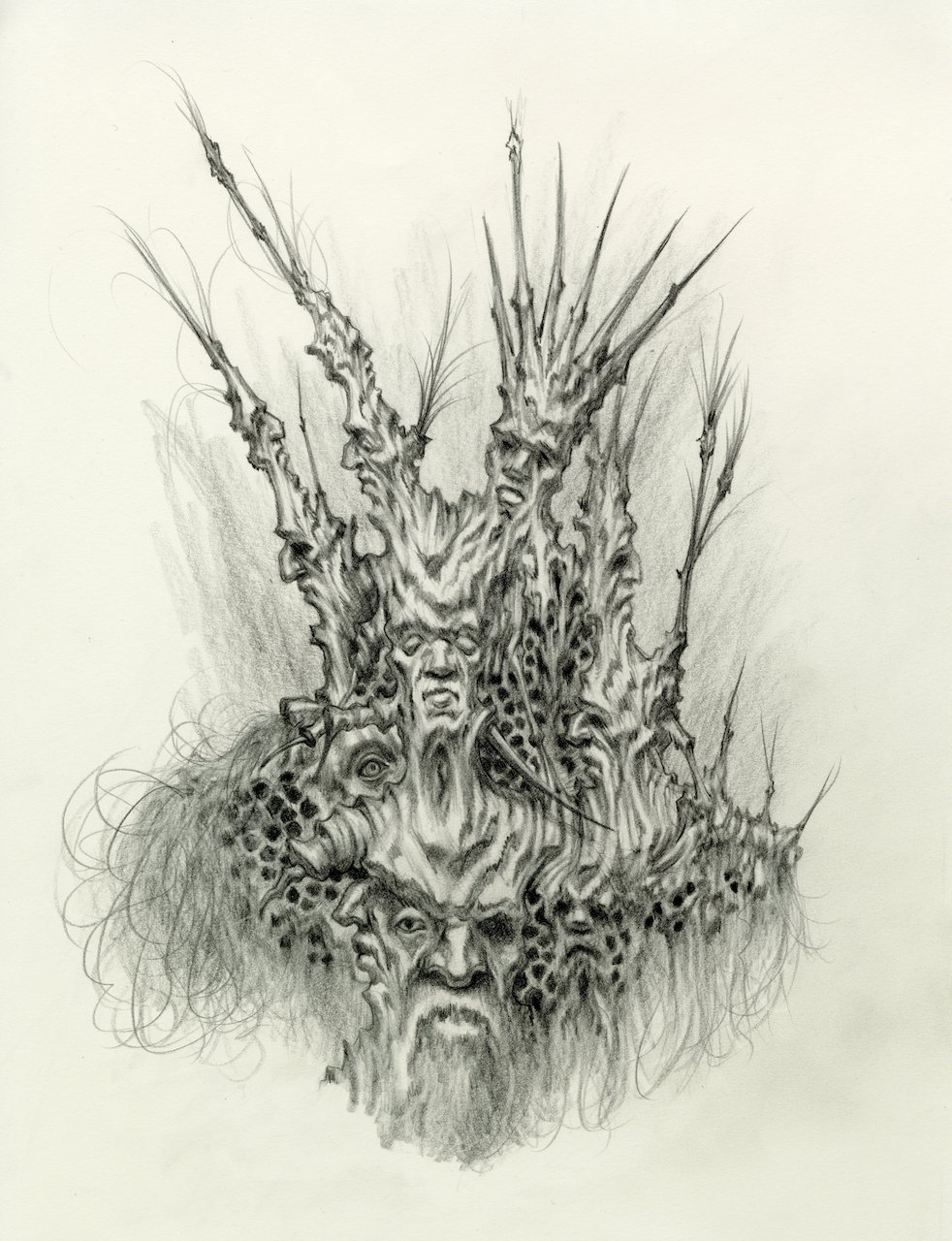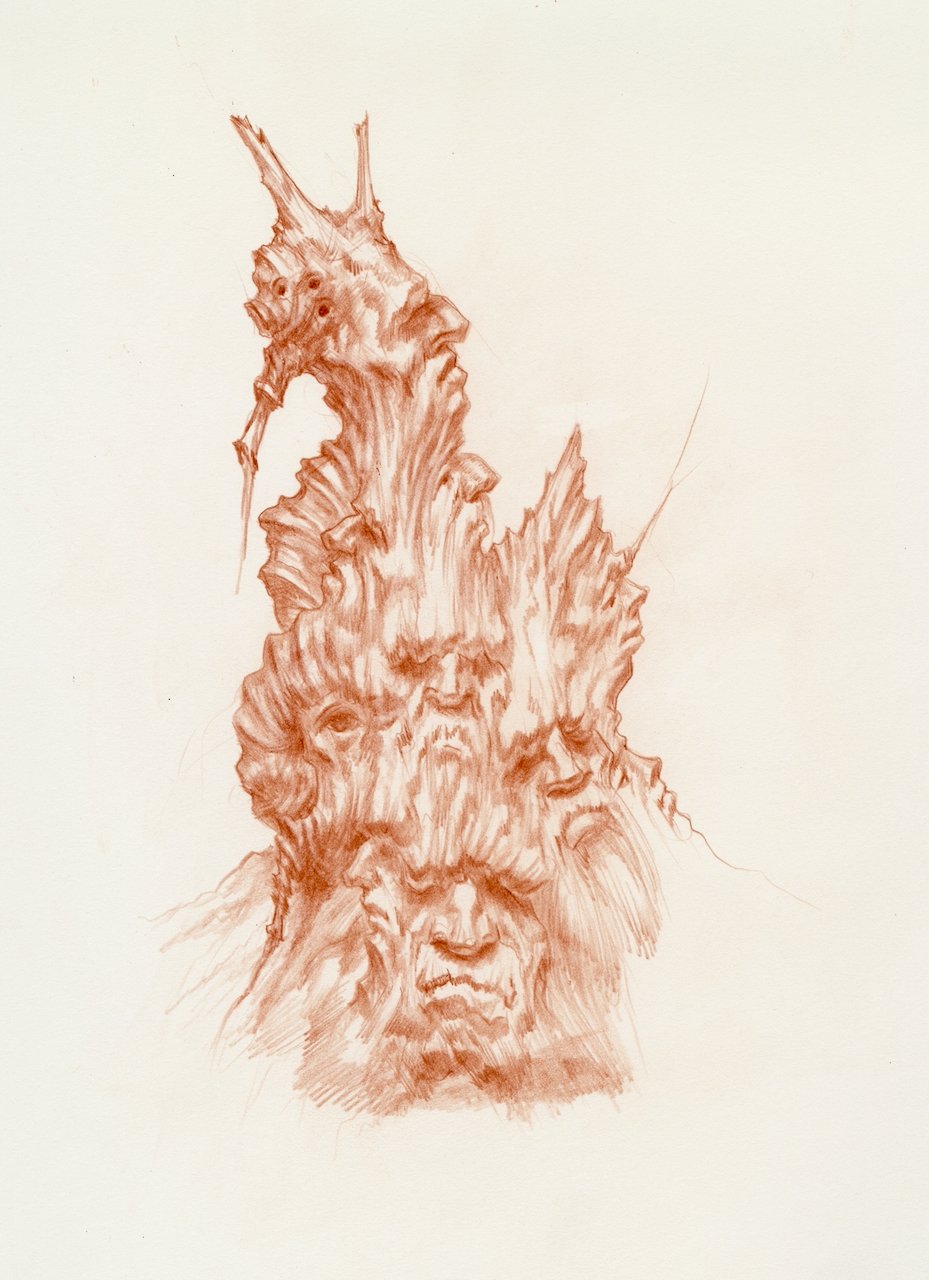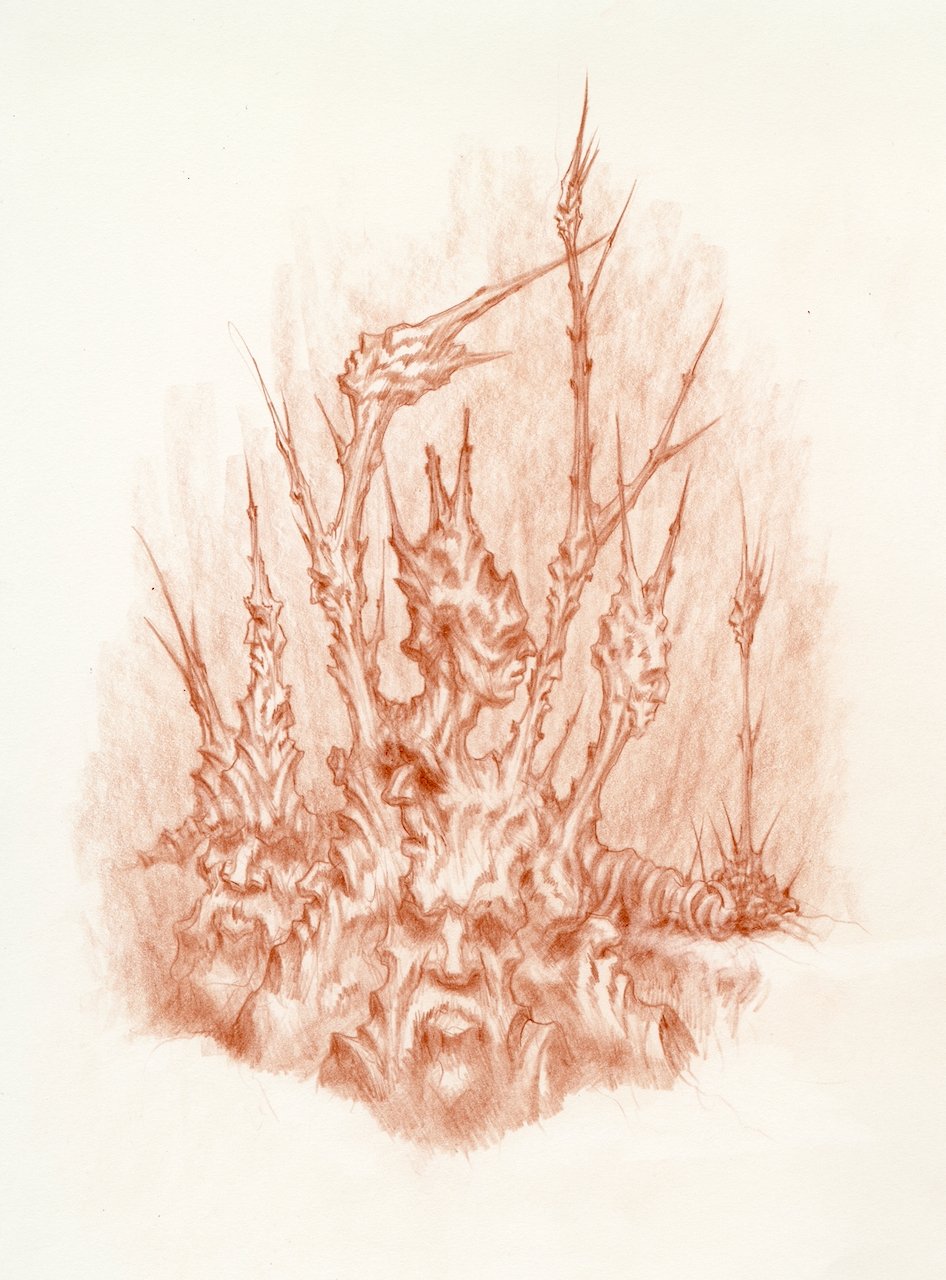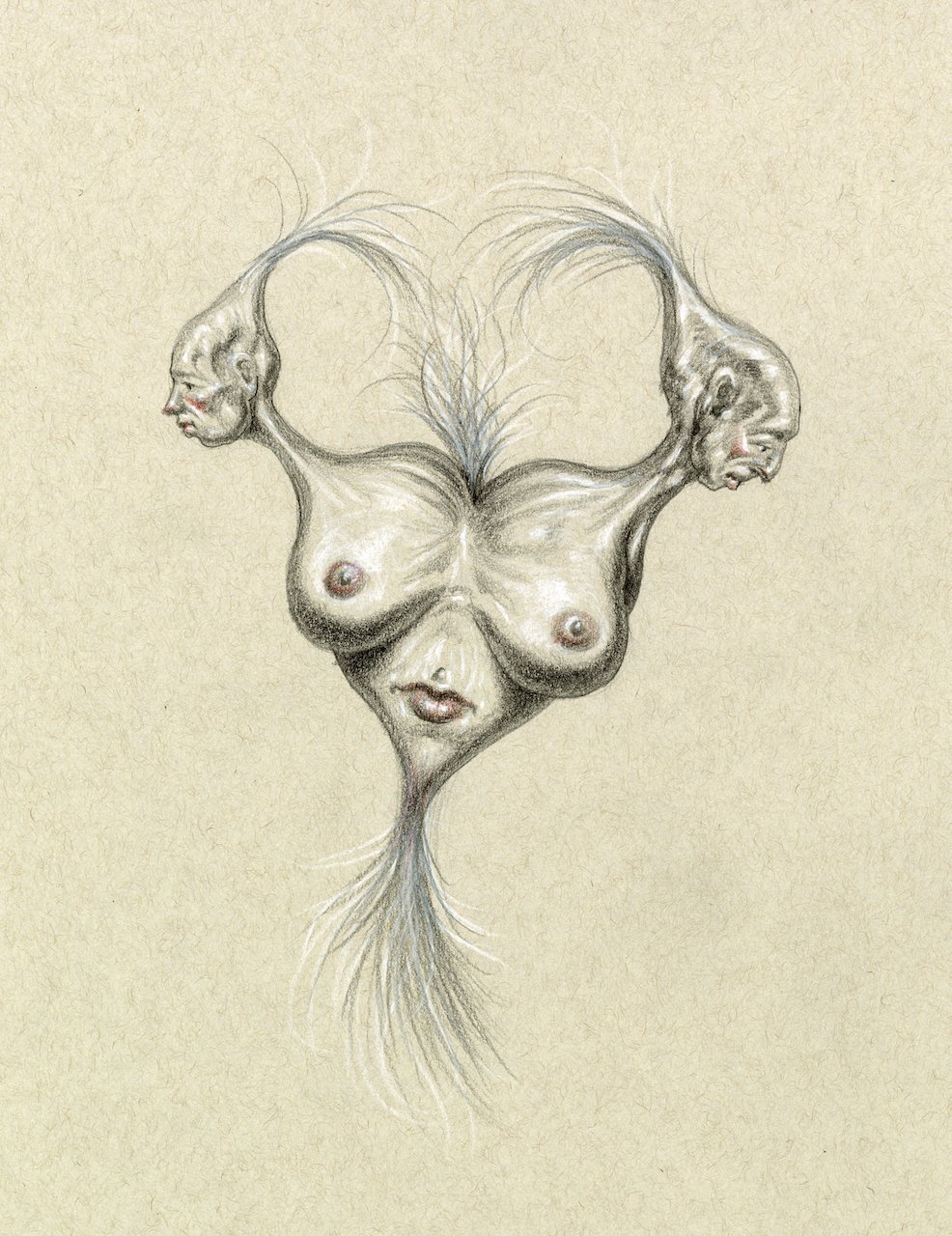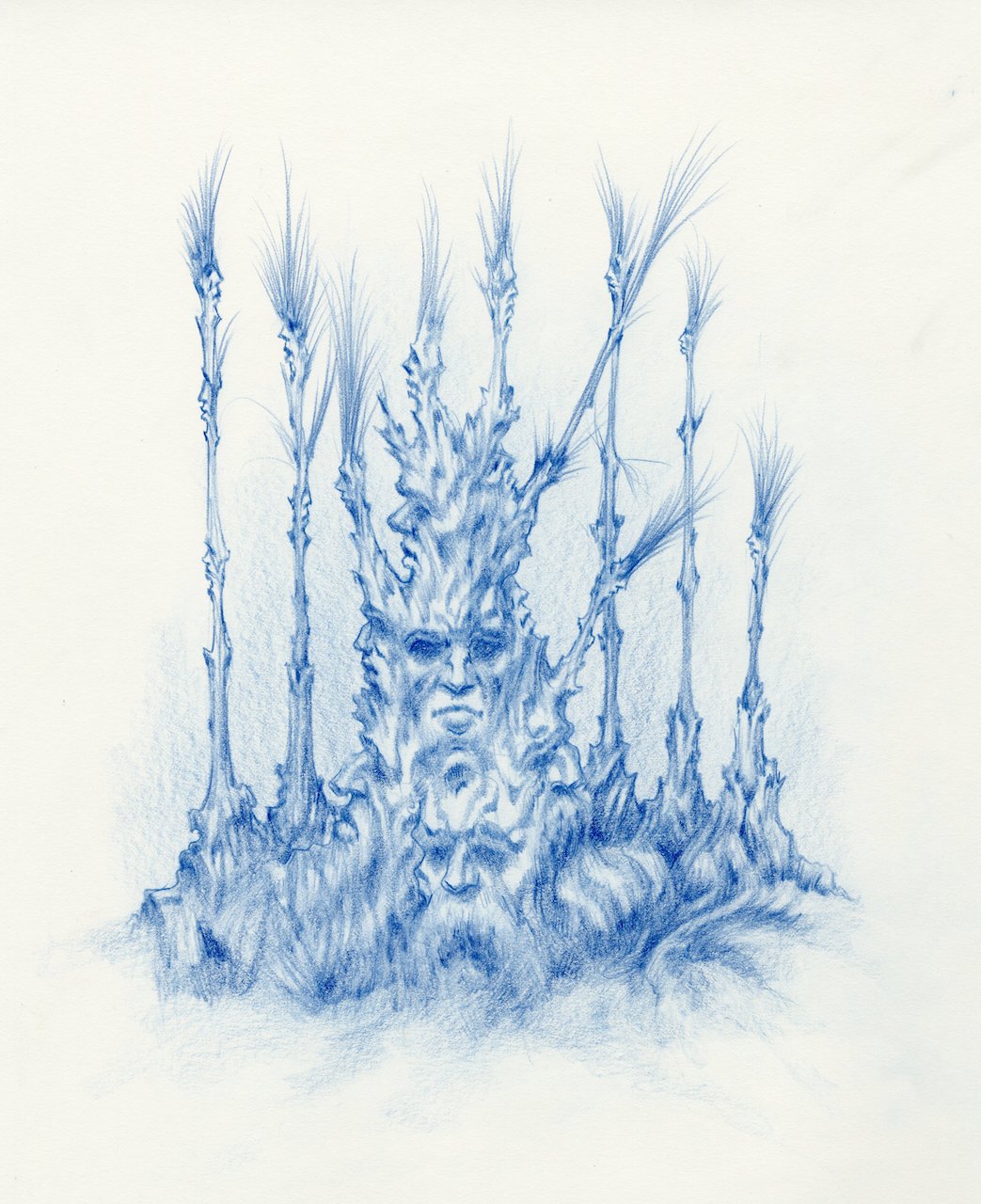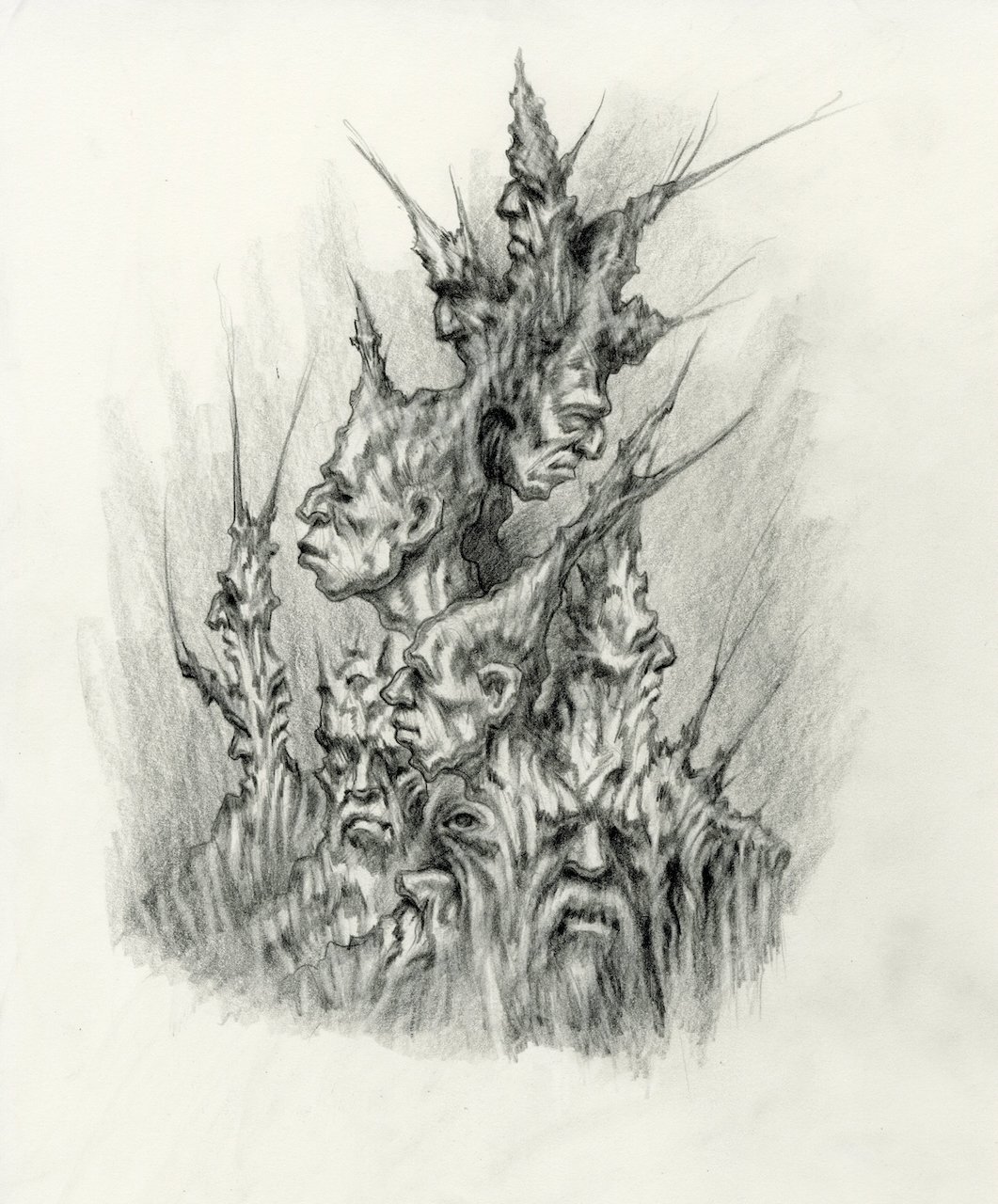The Dark Wood
“The Dark Wood” is a drawing series that explores the human condition through the lens of myth, organic transformation, and the inevitable cycles of time. Each drawing serves as a meditation on emergence, decay, and rebirth, portraying hybrid forms where tree, flesh, and memory converge. In this forest of becoming, form is never fixed. Bodies transform into roots, limbs fracture into branches, and faces stretch into bark. These images do not merely depict figures; they record a state of being, shaped by intellectual strain, spiritual evolution, and the weight of ancestral knowledge.
At its core, this series examines life and death as collaborators, not opposites. Here, physical strength is expressed not to glorify power but to symbolize intellectual resilience. The sinews of each form are crafted with intent, requiring anatomical understanding to convey their tension, fatigue, and latent vitality. These are not merely anatomical studies; they represent a deeper strength, the kind necessary to endure doubt, complexity, and change.
The stark, muscular figures in these works are crafted through a deliberate understanding of human anatomy. However, the body is not merely reproduced; it is reimagined, fusing with botanical elements and natural decay. Limbs become gnarled branches, torsos dissolve into stumps, and skin splits into bark. These forms exist within a suspended season, one of spiritual winter, where life lies dormant beneath a skeletal frame, and the forest waits not in death but in anticipation of return.
This anticipation is central. The figures stand with outstretched arms like bare trees in the cold wind, their trunks hollowed yet unbroken. These are beings caught between decline and rebirth. The sharp, brittle lines of their bark-like limbs echo the harshness of survival, yet their composure suggests clarity. These are not forms of despair; they are vessels of cyclical endurance.
The landscape of “The Dark Wood” is not a passive setting; it is a sentient presence. Faces emerge from the forest floor, stare out from knotted roots, and dissolve into fog. These faces, at once ancient and mournful, belong to sages, witnesses, and ancestors. They are the roots of thought, the sediment of history, and the wisdom that the present must either carry or deny. These forest beings are imbued with the spirit of The Dreaming Tree, a mythic entity within the series that grows not only from soil but from memory and thought. This tree is the heart of the dark wood, recording every dream, regret, and transformation that has ever occurred beneath its limbs.
Each drawing unfolds through the intricate layering of organic forms, fungal blooms, bark textures, and cellular beehive patterns, suggesting the interconnected nature of life and thought. These motifs serve not only as compositional elements but also as symbolic structures: hives denote collective labor, history, and unseen systems of memory; mushrooms and roots represent the mycelial wisdom of decomposition, emphasizing that growth arises from decay.
In many of the drawings, male and female forms appear to be fused into the forest, their gendered anatomies emphasized not for eroticism, but to explore polarity, unity, and transformation. Their gestures, whether seated in exhaustion or rising with their limbs extended, express stages of emotional and intellectual struggle. Some seem to reach out to others, while others appear lost in a trance or reverie. These forms represent our psychological fragmentation and longing, as well as our need to find coherence within chaos.
What unites these pieces is the belief that drawing is an act of excavation. Each line draws a figure from the void. Each mark is a root groping through darkness for light. As an artist, I draw not to replicate but to reveal, translating inner complexities into external form. These drawings are not born from observation alone, but from reflection, study, and immersion in anatomy, nature, and myth. Every curved limb, every hollow socket is informed by deep structural knowledge, transformed through imagination, and imbued with symbolic meaning.
In this forest, there is no clear path. Like Dante’s pilgrim or the dreaming mind, the viewer must navigate without a map or instructions. The way forward is found only through confrontation with mortality, uncertainty, and the unknown aspects of the self. Yet, in that darkness lies the promise of insight. These figures, despite their deformity and rootedness, possess a stillness, a knowledge earned not through dominance but through surrender to transformation.
The cyclical nature of time is reflected in the composition of each work. Figures are never static; they are caught in motion, emerging, decaying, and merging. The forest does not age; it mutates. Time in The Dark Wood is not linear but circular. Each being within it holds remnants of what it once was and whispers of what it may become. These drawings are not bound by narrative but by rhythm, by the pulse of life rising and falling in waves of breath and bark.
In some images, groups of figures appear to commune, kneeling, reaching out, or gathered in silence. They are not isolated protagonists, but rather members of a silent procession. Their physical strength reflects not individual heroism, but collective endurance, a lineage of thought carried through countless generations, etched into the very grain of the trees.
Color is used sparingly yet deliberately, with sepia tones, sanguine red, and earthy hues evoking the colors of blood, bark, and ash. The absence of vibrant colors reinforces a timeless quality; these are not events of the present, but rather myths that transcend time. White pencil highlights select edges, suggesting consciousness, revelation, or the first spark of becoming.
The Dark Wood invites the viewer not just to look, but to enter. It requires time, attention, and patience, much like the forest itself. Quick interpretation is resisted. Each form conceals more than it reveals. Faces appear only when the eye takes its time. Meaning unfolds not through explanation, but through communion.
In this body of work, the act of drawing serves as an act of remembering, not just biologically, but cosmologically. To draw is to anchor oneself in the past, to pull it through the hand, and to present it to the present. It is to say: here is the body that carried wisdom, that carried sorrow, that carried story. Here is the trunk, the branch, the broken hand, the buried eye. Here is what endures, even as it changes.
Ultimately, The Dark Wood serves as a sanctuary of complexity. It is not a place of fear but of inquiry. Here, physical forms carry intellectual weight, and knowledge is the soil from which transformation grows. It is a forest of thought, seeded with memory and nurtured by time, where every fallen limb and every scarred trunk represents evidence not of destruction but of survival. Ultimately, survival is an act of strength, encompassing the body, the spirit, and the mind.
The Dark Wood, By Michael M Hensley
The Dark Wood, By Michael M Hensley
The Dark Wood, By Michael M Hensley
Metamorphosis, By Michael M Hensley
Metamorphosis, By Michael M Hensley
Metamorphosis, By Michael M Hensley
Metamorphosis, By Michael M Hensley
Metamorphosis, By Michael M Hensley
The Dark Wood, By Michael M Hensley
The Dark Wood, The Sentinel, By Michael M Hensley
The Dark Wood, By Michael M Hensley
The Dark Wood, By Michael M Hensley
The Dark Wood, By Michael M Hensley
The Dreaming Tree, Trunks, Roots, and Limbs, By Michael M Hensley
The Dreaming Tree, Trunks, Roots, and Limbs, By Michael M Hensley
The Dreaming Tree, Trunks, Roots, and Limbs, By Michael M Hensley
The Dreaming Tree, Trunks, Roots, and Limbs, By Michael M Hensley
The Dreaming Tree, Trunks, Roots, and Limbs, By Michael M Hensley
The Seed, By Michael M Hensley
The Seed, By Michael M Hensley
The Dark Wood, Blood Moon, By Michael M Hensley
The Dreaming Tree, Trunks, Roots, and Limbs, By Michael M Hensley
The Dreaming Tree, Trunks, Roots, and Limbs, By Michael M Hensley
The Dreaming Tree, Trunks, Roots, and Limbs, By Michael M Hensley
The Dreaming Tree, Trunks, Roots, and Limbs, By Michael M Hensley
The Dreaming Tree, Trunks, Roots, and Limbs, By Michael M Hensley
The Dark Wood, By Michael M Hensley
The Council of the Wood, By Michael M Hensley
The Dark Wood, By Michael M Hensley
The Dark Wood, By Michael M Hensley
The Dark Wood, By Michael M Hensley
The Dark Wood, By Michael M Hensley
The Dark Wood, By Michael M Hensley
The Dark Wood, By Michael M Hensley
The Dark Wood, By Michael M Hensley
The Dark Wood, By Michael M Hensley
The Dark Wood, By Michael M Hensley
The Dark Wood, By Michael M Hensley
The Dark Wood, By Michael M Hensley
The Dark Wood, By Michael M Hensley
The Dark Wood, By Michael M Hensley
The Leafling, By Michael M Hensley
The Dark Wood, By Michael M Hensley
The Dark Wood, By Michael M Hensley
The Dark Wood, By Michael M Hensley
The Dark Wood, By Michael M Hensley
The Dark Wood, By Michael M Hensley
The Dark Wood, By Michael M Hensley
The Dark Wood, By Michael M Hensley
The Dark Wood, By Michael M Hensley
The Dark Wood, By Michael M Hensley
The Dark Wood, By Michael M Hensley
The Dark Wood, By Michael M Hensley
The Leafling, By Michael M Hensley
The Dark Wood, By Michael M Hensley
The Dark Wood, By Michael M Hensley
The Dark Wood, By Michael M Hensley






